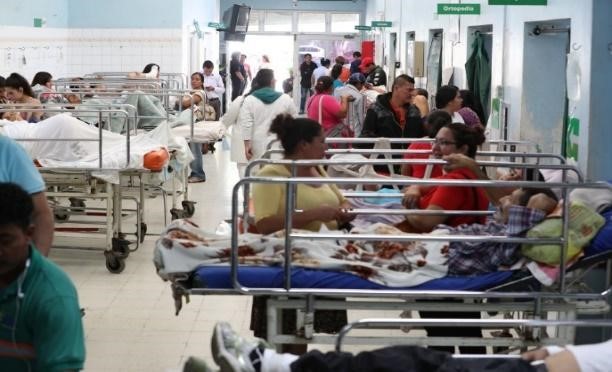Saturation and overcrowding of the emergency service of an urban hospital
Saturación y hacinamiento del servicio de emergencia de un hospital urbano
DOI:
https://doi.org/10.25176/RFMH.v20i2.2709Keywords:
Health Services Needs and Demand, Emergency Medical Services, CrodwingAbstract
Over-demand and overcrowding is a problem in the emergency department of our environment.
Objective: to determine the characteristics of the demand for medical care at the emergency department of a tertiary social security hospital.
Methodology: observational study at Rebagliati hospital, first quarter 2019. Sociodemographic, time and emergency indicators of the institutional statistical system, descriptive statistical statistics with IBM SPSS 24.00 were evaluated.
Results: 51294 patient care between 14 and 102 years (median 60), 56.7% female sex, 18% recorded more than one visit in the quarter. Monday was the day of greatest demand and the schedule between 8 and 13 hours. Priority attention 3 and 4 corresponded to 60.8 and 20.8% of the total. The topics of medicine, relief and surgery performed 41, 22 and 20% of attentions respectively. In the shock trauma unit, 3% of attentions were performed. 13% attention was admitted to observation rooms. The most frequent diagnoses were respiratory failure, infections and strokes. 88% of admissions were made in common rooms with a stay between 4.4 and 7.0 days. 0.8% of those treated died, 0.7% performed surgery and 0.1% transferred to another hospital.
Conclusion: the demand to the emergency department is mainly due to medical problems (priority 3 and 4), predominantly elderly and female patients. 13% of attention were admitted, with long stay, low mortality, very few transfers, high return rate and low supply of hospital beds.
Downloads
References
2. Vásquez Alva R, Amado Tineo J, Ramírez Calderón F, Velásquez Velásquez R, Huari Pastrana R. Sobredemanda de atención médica en el servicio de emergencia de adultos de un hospital terciario, Lima, Perú. An la Fac Med [Internet]. 2016 Dec 16;77(4):379.
3. Amado J, Vasquez R, Huari R, Palacios A. Readmision frecuente de pacientes al servicio de emergencia de adultos de un hospital terciario. Lima-Peru 2012. Rev Soc Peru Med Interna. 2015;28(4):153–7.
4. Taype-Huamani W, Chucas-Ascencio L, Amado-Tineo J. Hacinamiento del servicio de emergencia de adultos del hospital Rebagliati: Reporte de caso. Rev med Rebagliati. 2018;1(2):50–5.
5. Ponce Varillas TI. Hacinamiento en los servicios de emergencia. An Fac med. 2017;78(2):218-223.
6. Hsu N-C, Shu C-C, Lin Y-F, Yang M-C, Su S, Ko W-J. Why do general medical patients have a lengthy wait in the emergency department before admission? J Formos Med Assoc. 2014 Aug;113(8):557–61.
7. Smith J, Keating L, Flowerdew L, O’Brien R, McIntyre S, Morley R, et al. An Emergency Medicine Research Priority Setting Partnership to establish the top 10 research priorities in emergency medicine. Emerg Med J. 2017;34(7):454–6.
8. Hsu CM, Liang LL, Chang Y Te, Juang WC. Emergency department overcrowding: Quality improvement in a Taiwan Medical Center. J Formos Med Assoc. 2019;118(1P1):186–93. DOI: 10.1016/j.jfma.2018.03.008
9. Giunta DH, Pedretti AS, Elizondo CM, Grande Ratti MF, González Bernaldo de Quiros F, Waisman GD, et al. Descripción de las características del fenómeno Crowding en la Central de Emergencia de Adultos, en un hospital universitario de alta complejidad: estudio de cohorte retrospectiva. Rev Med Chil. 2017 May;145(5):557–63.
10. Wang Z, Xiong X, Wang S, Yan J, Springer M, Dellinger RP. Causes of Emergency Department Overcrowding and Blockage of Access to Critical Services in Beijing: A 2-Year Study. J Emerg Med. 2018 May;54(5):665–73.
11. Taype-Huamaní W, Chucas-Ascencio L, Cruz-Rojas L De, Amado-Tineo J. Tiempo de espera para atención médica urgente en un hospital terciario después de implementar un programa de mejora de procesos. An Fac Med. 2019;80(4):438–42.
12. Taype-Huamaní W, Rojas-De la Cruz L, Miranda-Soler D, Amado-Tineo J. Características de la demanda no urgente en el Servicio de Emergencia de un hospital de la Seguridad Social en el Perú. Rev la Fac Med Humana. 2020;20(1):45–51.
13. Acosta AM, Lima MAD da S. Frequent users of emergency services: Associated factors and reasons for seeking care. Rev Lat Am Enfermagem. 2015;23(2):337–44.
14. Defensoría del Pueblo. El derecho a la salud: Los servicios de emergencia en los establecimientos de salud públicos y el acceso a medicamentos esenciales. Lima-Perú; 2016.
15. De la Cruz-Ore J. Evaluación del uso inapropiado de los servicios de emergencia de un hospital del seguro social en Lima Perú. Rev cient. 2019;2(28):36–44.
16. Contreras-Camarena C, Galarza-Manyari C. Hospitalizaciones inadecuadas en emergencias médicas. Rev Soc Peru Med Interna. 2011;24(1):19–25.

Downloads
Published
How to Cite
Issue
Section
License
Copyright (c) 2020 Revista de la Facultad de Medicina Humana

This work is licensed under a Creative Commons Attribution 4.0 International License.



































